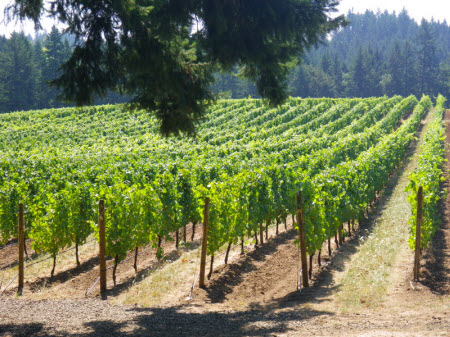The Vineyard
The Ribbon Ridge Vineyards site is located on the shoulder of Ribbon Ridge in Yamhill County in close proximity to Chehalem's Ridgecrest Vineyard, Beaux Freres Vineyard, Brick House Vineyard, Whistling Ridge Vineyard and Patricia Green Cellars. The predominant soil type has long been considered Willakenzie clay loam, though more recent surveys indicate a variety of clay loam soils on Ribbon Ridge, with six related soil types found in Ribbon Ridge Vineyards. The entire property encompasses 41.13 acres, with approximately 12 acres cleared and 30 acres in timber.
In Spring 2001, nine acres of grapes were planted on ten acres. These plantings produced a limited commercial harvest in 2003 and produced a full harvest of 27 tons of grapes in 2006 - enough to produce up to 1600 cases of wine. An additional 11 acres is plantable and is targeted to be planted over the next several years bringing the total vineyard acreage to 20 acres.

Half of the harvests are contracted to Scott Paul wines. Their wines are consistently held in high regard by critics and consumers alike they they have demonstrated a deft touch with our fruit. If you are at their tasting room in Carlton, look for their D122 -- a special offering made exclusively from Ribbon Ridge Vineyard fruit.
Andrew Rich, another great winemaker producing highly sought-after Pinot noirs, has also been using Ribbon Ridge Vineyard fruit since the beginning. He consistently produces great wine from our fruit and even has produced several exceptional vineyard designate wines. We are delighted to have Andrew as part of the RRV family.
The balance of the fruit is used in our estate and reserve Pinot noir. The majority of our fruit comes from a section of the vineyard we call the Wedding Block. This section is at the highest point in the vineyard and is an area with the thinnest topsoil. It tends to produce slightly more intense fruit flavors that add more character and depth to the wines. Plus it has special significance to us -- this is where we were married in 1978. (See the Winemaking link.)
Vineyard Development Strategy
Techniques and strategies that historically have yielded excellent results.
Clones and Rootstock
Pommard and Dijon 777 grafted onto 3309C rootstock.
Other Considerations
Grow tubes, drain tile, electronic temperature monitors, and Oregon LIVE.
|



